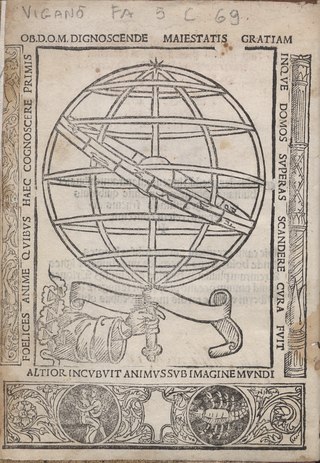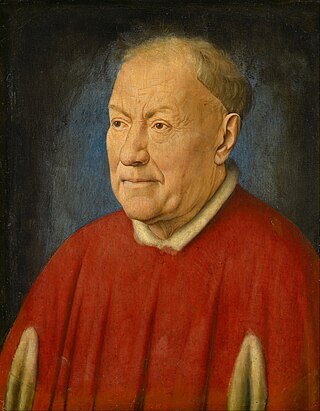
Francesco I Sforza was an Italian condottiero who founded the Sforza dynasty in the duchy of Milan, ruling as its (fourth) duke from 1450 until his death.

Andrea del Castagno or Andrea di Bartolo di Bargilla was an Italian Renaissance painter in Florence, influenced chiefly by Masaccio and Giotto di Bondone. His works include frescoes in Sant'Apollonia in Florence and the painted equestrian monument of Niccolò da Tolentino (1456) in Florence Cathedral. He in turn influenced the Ferrarese school of Cosmè Tura, Francesco del Cossa and Ercole de' Roberti.
This article is a list of the literary events and publications in the 15th century.

The Basilica di Santa Croce is a minor basilica and the principal Franciscan church of Florence, Italy. It is situated on the Piazza di Santa Croce, about 800 metres southeast of the Duomo, on what was once marshland beyond the city walls. Being the burial place of notable Italians, including those from the Italian Renaissance such as Michelangelo, Galileo, and Machiavelli, as well as the poet Foscolo, political philosopher Gentile and the composer Rossini, it is also known as the Temple of the Italian Glories.

John of Capistrano, OFM was a Franciscan friar and Catholic priest from the Italian town of Capestrano, Abruzzo. Famous as a preacher, theologian, and inquisitor, he earned himself the nickname "the Soldier Saint" when in 1456 at age 70 he led a Crusade against the invading Ottoman Empire at the siege of Belgrade with the Hungarian military commander John Hunyadi.

Sylvester Mazzolini, in Italian Silvestro Mazzolini da Prierio, in Latin Sylvester Prierias (1456/1457–1527), was a theologian born at Priero, Piedmont; he died at Rome. Prierias perished when the imperial troops forced their way into the city, leading to the Sack of Rome.

Catherine of Bologna [Caterina de' Vigri] was an Italian Poor Clare, writer, teacher, mystic, artist, and saint. The patron saint of artists and against temptations, Catherine de' Vigri was venerated for nearly three centuries in her native Bologna before being formally canonized in 1712 by Pope Clement XI. Her feast day is 9 March.

The Wars in Lombardy were a series of conflicts between the Republic of Venice and the Duchy of Milan and their respective allies, fought in four campaigns in a struggle for hegemony in Northern Italy that ravaged the economy of Lombardy. They lasted from 1423 until the signing of the Treaty of Lodi in 1454. During their course, the political structure of Italy was transformed: out of a competitive congeries of communes and city-states emerged the five major Italian territorial powers that would make up the map of Italy for the remainder of the 15th century and the beginning of the Italian Wars at the turn of the 16th century. They were Venice, Milan, Florence, the Papal States and Naples. Important cultural centers of Tuscany and Northern Italy—Siena, Pisa, Urbino, Mantua, Ferrara—became politically marginalized.

Niccolò dell’Arca was an Italian Early Renaissance sculptor, who worked mostly in terracotta. He is also known under the names Niccolò da Ragusa, Niccolò da Bari, Niccolò dall'Arca, and Niccolò d'Antonio d'Apulia. The surname “dell’Arca” refers to his contribution to the Arca di San Domenico.
Flaminius Annibali de Latera was an Italian historian.

San Marco is a Catholic religious complex in Florence, Italy. It comprises a church and a convent. The convent, which is now the Museo Nazionale di San Marco, has three claims to fame. During the 15th century it was home to two famous Dominicans, the painter Fra Angelico and the preacher Girolamo Savonarola. The church houses the relics of St Antoninus of Florence and the tomb of Pico Della Mirandola, a Renaissance philosopher known as the "Father of Humanism."
The decade of the 1490s in art involved some significant events.
The decade of the 1440s in art involved some significant events.

Niccolò Albergati was an Italian Carthusian and a prelate of the Roman Catholic Church. He was appointed cardinal and served as a papal diplomat to France and England (1422–23) in addition to serving as the bishop of Bologna from 1417 until his death.

Pacificus da Ceredano - born Pacificus Ramati - was an Italian Roman Catholic priest and a professed member from the Order of Friars Minor. Pope Benedict XIV approved his "cultus" and beatified him on 7 July 1745.

Francesco Panigarola was an Italian Franciscan preacher and controversialist, and Bishop of Asti.
San Niccolò is a Roman Catholic church located on Via Pompeiana 25 in the town of Osimo, in the province of Ancona, region of Marche, Italy.

Niccolò Bonafede was a Roman Catholic prelate who served as Bishop of Chiusi (1504–1533).













